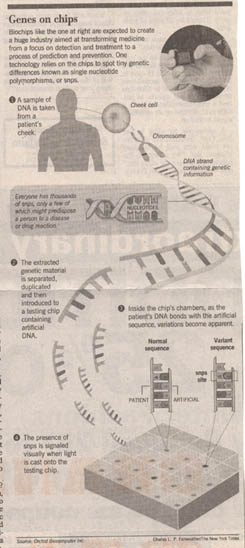DNA microchips will soon be able to reveal to anyone an accurate profile of your personality and potential
All things change, I am told, but I greatly fear one change about to overcome us in the new millennium — loss of individual privacy. I don’t mean strangers listening through key holes or reading my e mail. I have something much more personal in mind.
What I fear I shall lose in the coming decade is my private sense of self, that unique collection of foibles and strengths that make me a particular person — one who wears clogs, is a bit over-feisty, and takes lipitor to keep my cholesterol down. Before this decade ends, a simple sample of my blood, tested with a biochip, will quickly and cheaply yield a computer characterization of my genes, a summary that can reveal to any stranger the secrets of my innermost self.
A biochip, also called a gene microarray, is a square of glass smaller than a postage stamp, covered with millions of strands of DNA like blades of grass. Biochips were invented nine years ago by gene scientist Stephen Fodor. In a flash of insight, he saw that photolithography, the process used to etch semiconductor circuits into silicon, could also be used to assemble particular DNA molecules on a chip — a biochip.
Think of the chip surface as a field of assembly sites, much as a TV screen is a field of colored dots. Just as a scanning beam moves over each individual TV dot instructing it to be red, green, or blue (the three components of color), so a scanning beam moves over each biochip spot, commanding the addition there of a base to a growing strand of DNA. A computer, by varying the wavelength of the scanning beam, determines which of four possible units, called nucleotides, is added to the growing DNA strand anchored to each spot. When the entire chip has been scanned, each DNA strand has been lengthened one nucleotide unit. The computer repeats the process, layer by layer, until each DNA strand is an entire gene or gene fragment. One biochip made in this way contains hundreds of thousands of specific gene sequences.
How could you use such a biochip to delve into my genes? All you would have to do is to obtain a little of my DNA, say from a blood sample or even a bit of hair. Flush fluid containing my DNA over the biochip surface. Every place my DNA has a gene matching one of the biochip strands, it will stick to it in a way the computer can detect.
Now here is where it gets interesting — and scary. The mad rush to sequence the human genome is over. The gene research firm Celera announced Monday it has essentially completed the sequence, with over 90% of genes done. Already the researchers are busily comparing their consensus “reference sequence” to the DNA of individual people, and noting any differences they detect.
Called single nucleotide polymorphisms, or snps (pronounced “snips”), these spot differences in the identity of particular nucleotides record every way in which a particular individual differs from the reference sequence. Some single nucleotide snips cause diseases like cystic fibrosis or sickle cell anemia. In my case, particular snps give me red hair and elevated levels of cholesterol in my blood. Everything genetic about me that is different from you is caused by a few thousand snps; otherwise you and I are identical.
The scary part is snps on chips. Researchers plan to have identified some 300,000 different snps by year’s end, all of which could reside on a single biochip. When my DNA is flushed over a snp biochip, the sequences that light up will instantly reveal my snp profile. Everything about me that makes me me, every gene that might affect my health, my behavior, my future potential — all are there to be read by any stranger clever enough to interpret the profile.
To what extent am I my genes? Scientists fight about this question, and I don’t know the answer. I do know that much of what I am like is strongly affected by my genetic makeup. Researchers have proven beyond any real dispute that intelligence and major personality traits like aggressiveness and inquisitiveness are about 80% heritable (that is, 80% of the variation in these traits reflects variation in genes).
My snp profile will reflect all of this variation, a table of contents of my chromosomes, a molecular window to my soul. When millions of such snp profiles have been gathered — and we’re talking years, not decades — any computer worth keeping will be able to identify other individuals with profiles like mine, and, by examining health records, standard personality tests, and the like, correlate parts of my profile with particular traits.
There is no place my identity can hide. Even behavioral characteristics involving many genes, which until now have been thought too complex to ever analyze, cannot resist a determined assault by a computer comparing snp profiles.
All this lies in the future, but not far, I’d wager.
©Txtwriter Inc.
